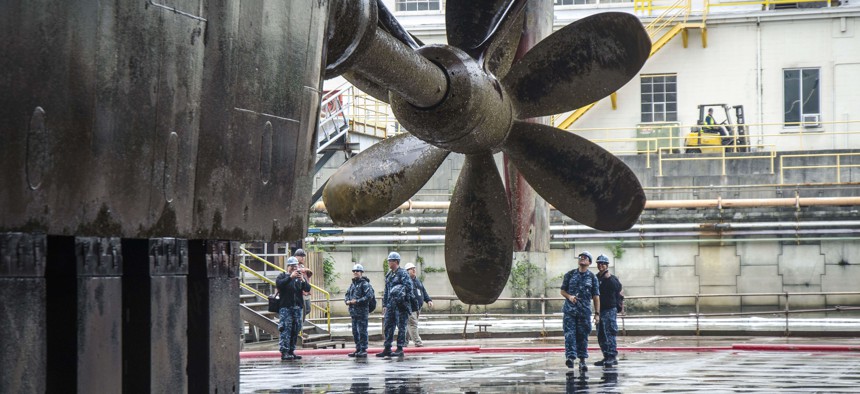
Sailors assigned to the submarine tender USS Frank Cable (AS 40) see their ship's propeller for the first time, as she drains in dry-dock, in Portland, Ore. U.S. Navy / Mass Communication Specialist 3rd Class Alana Langdon
Navy: US Can’t Build Trump’s Planned Fleet — Unless AI Can Slash Costs
The nation's defense strategy depends on using advanced tech to build and repair warships more cheaply, says acquisition chief James "Hondo" Geurts.
The U.S. industrial base can’t build the 355-ship fleet required by national strategy, nor can the Navy afford to repair it — unless the military and industry can use AI and other advanced technologies to slash costs, the service’s top acquisition official said Tuesday.
“For the Navy and the Marine Corps, if we can’t solve and fundamentally drive some of the costs out of these ships over the long term, both in construction and in repair, we’re not going to be able to achieve the National Defense Strategy,” said James "Hondo" Geurts, assistant Navy secretary for research, development and acquisition.
Geurts spoke Tuesday at the Defense One Tech Summit in Washington, D.C.
“It’s not intuitive that at a tech conference, we’d be talking about shipbuilding,” he said. “But quite frankly, there are so many technologies that could fundamentally shift the cost curves and the affordability curves in shipbuilding, those that can make the connection first will have great market opportunities.
“There’s kind of this notion that shipbuilding’s a pure sweat-and-muscle game,” he said, “But you look at some of the places you can apply technology now that you have a digital ship from the start” — meaning one that was designed and to some extent modeled and simulated digitally.
Start with training, he said. “The industrial base isn’t nearly as strong as it used to be, particularly on the skilled trades.” Half of shipbuilding employees have less than five years’ experience. “I can wait 25 years until they have 30 years’ experience, or I can find ways to accelerate that training.”
Then work on construction. The first Ford-class aircraft carrier took 30 to 40 million man-hours to build, while the second will require something like 19 percent fewer, he said. But that curve has to keep coming down if the fleet is going to grow fast enough to meet the defense strategy. AI can help, he suggested.
Then there’s ship repair, another traditionally capital-intensive endeavor that must become far more efficient if the National Security Strategy is to succeed, Guerts said. Right now, he said, the surface fleet alone requires an average of 100 major ship repairs each year — and that’s only going to increase as the fleet grows.
“We have to drive out costs of ship repair; otherwise, we won’t be able to afford the fleet we have,” he said.
Guerts put out a call to industry.
“Folks that can help us get to that point, I think will be very, very interesting to meet...There’s a large opportunity space for folks to help in that, who have not traditionally been able to get into that market,” he said. Companies and people “who make AI tools, machine learning tools, unmanned tools — I would ask you to think more broadly than ISR and some of the more traditional problems.”
Related: How to Grow the Military Without Buying More Ships, Planes, Tanks
Related: Boeing, Shipbuilder Team Up to Build Giant Underwater Drones
Related: L3 Shops for a Shipyard — and a Place in the Defense Industry’s Top Tier
Guerts said his mission was delivering lethal combat capability, which he said depended on three elements that do so at different speeds and cost:
- Shipbuilding. “That’s ‘how much stuff do you have,’” he said. “How do we most affordably and predictably build the ships the Navy needs?”
- Capability. “How do I get exponential capability growth on all the ships I currently have?” Algorithmic warfare, networking — these things can increase total capability faster than shipbuilding alone can grow the fleet.
- Availability. “The fastest way to grow capability is to use all that you currently have. That’s where I think there is great opportunity space, because traditionally we haven’t applied the same level of technology to try to get at that.”




